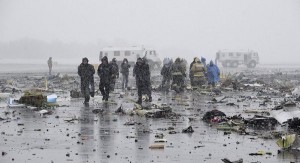Airliner Crash Wind Shear
By Michael FaginGeneral Info, Weather for Pilots, Wind ShearWith 0 comments
Plane crash site: Photo credit http://www.airlive.net/flydubai/
The March 19th crash of Flydubai Flight FZ 891 of a Boeing 737-800 aircraft resulted in the deaths of the 55 passengers and 7 crew members aboard. This occurred at Don Airport Russia. Early data suggests some wind shear issues.
The flight, originating in Dubai, UAE was a regular scheduled trip with an experienced flight crew aboard. The Russian Civil Aviation Committee are the lead investigators in cooperation with Boeing and the French engine manufacturer. The cockpit voice recorder and flight data recorder were recovered and sent to Moscow to be copied and examined. Early reports stated that while mostly intact some damage to both was noted. Priority is being given to the data recorder as it will contain the information regarding the speed, altitude, engine performance etc., of the aircraft.
Weather related issues are suspected, but not as yet confirmed, as a major contributing factor. The weather at the time leading up to the crash was locally stormy with rain and mixed low visibility. A weather front was in the area and wind shear is known to have been in place.
Wind shear is a phenomenon related to storms, especially thunder storms but also to frontal activity. Shear can be either horizontal or vertical. At low altitudes, especially below 500 meters, 1650 feet, the sudden downdraft such as from a descending cold air from a frontal boundary may exceed hurricane force in a very small area.
The weather conditions at the time were within flight parameters but The pilots of this aircraft had already aborted one landing attempt and an Areoflot flight had diverted to another airfield after having failed to land.
The Flydubai crew chose to circle the field for about two hours and after seeing three other flights land safely made their attempt.
It appears that on their final approach, the most sensitive time of any flight, that once below 500 meters, where winds were reported at 64 MPH and above, they encountered wind shear which threw the aircraft into a descent rate of 21,000 feet per minute rather than a more usual 500 feet per minute descent.
A local security camera video shows the incident with the aircraft descending at between 45 and 60 degrees. The wind forces may have overwhelmed the lift of the wings and caused a stall. Given that there is a 5 to 10 second lag in applying power to turbofan engines from when the throttles are pushed forward The crew simply had insufficient altitude to recover.
The final analysis of the crash will be determined by the Civil Aviation authorities in Moscow. Analysis of the flight data and interviews with witnesses as well as a thorough examination of the aircraft maintenance logs may well take more than a year. In speaking with an expert pilot and crash investigator he explained that there is never just one cause to an accident. The flight crew were experienced and professional. The aircraft reasonably new and reliable. All early reports indicate that the aircraft and engines were in excellent condition and recently inspected.
This article is not intended as a detailed weather analysis. This is just a general summary of events that occurred. Article written by Robert Morthorst and edited by Operational Meteorologist Michael Fagin
